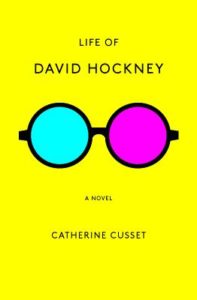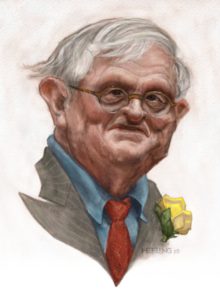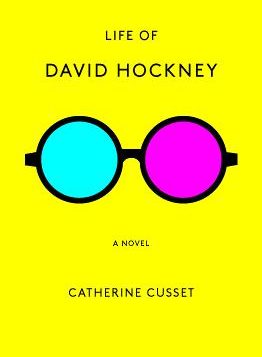 Life of David Hockney: A Novel
Life of David Hockney: A Novel
by Catherine Cusset
Translated from the French by Teresa Lavender Fagan
Other Press. 192 pages, $15.99
THIS BRIEF, charming novel blends fiction and biography in the genre of “biofiction” to tell the life story of artist David Hockney from childhood to recent years, in the process capturing the evolution of his art, career, and relationships.
Author Catherine Cusset explains in her prologue to Life of David Hockney that “this is a novel. All the facts are true, but I have imagined feelings, thoughts, and dialogue,” drawn from many sources, including “autobiographies, biographies, interviews, essays, films, and articles.” A select bibliography of works used “given in order of importance” is included at the end, showing how much research Cusset undertook in preparing to write this novel.
The start of the book shows the unconventional stance within David’s family, as his father Ken protests World War II, leading to the loss of his job and of government assistance, plus the alienation of his neighbors. The “big life lesson” he teaches his children is “don’t be concerned with what the neighbors think.” Hockney takes this lesson to heart, pursuing his passion and talent for art, first at the Bradford School of Art and then at the Royal College of Art in London. At first fearing that his interest in figure painting meant he could not be a modern artist, a friendship with a fellow student named Ron taught him that he should paint “things that matter to you.” “There was no point in struggling to belong to one’s time—one belonged to it by definition.” This idea freed him to “paint what I like when I like, and where I like,” as he tells a gallery owner, unconcerned with fads and the whims of critics. It has led to a career characterized by experimentation with different subjects, different techniques, and different media, including the iPhone’s “Brushes” app in a recent series.
His homosexuality has deeply informed the making of his art. Having been caught by a friend having sex with a boy, having been ashamed and then angry about his shame, Hockney created a work called Shame, “without any other identifiable shape than that of an erect penis in the foreground.” Later, when living in L.A., he would make a series of paintings of beautiful young men in swimming pools.
 The novel explores his romantic relationships in detail. One longtime partner, Peter, is a student in a class Hockney teaches in L.A., “still a teenager” who came to the class by accident. Hockney enjoys teaching the beautiful boy, driving six hours to see him every weekend. They live a charmed existence together until Peter’s own ambition to become an artist causes tension between them. After Peter leaves, Hockney is devastated, spending months hoping to win him back, only to realize he cannot recapture the moment. Decades later, returning to England, he creates a family of sorts with his chief assistant JP, “like an adult and independent son,” and Dom, “the child of the house,” who left university to work full-time for Hockney. He thinks of the trio as “a community of free spirits and bodies” living in “an island of freedom” where “they could smoke, drink, create all the artificial paradises they wanted.”
The novel explores his romantic relationships in detail. One longtime partner, Peter, is a student in a class Hockney teaches in L.A., “still a teenager” who came to the class by accident. Hockney enjoys teaching the beautiful boy, driving six hours to see him every weekend. They live a charmed existence together until Peter’s own ambition to become an artist causes tension between them. After Peter leaves, Hockney is devastated, spending months hoping to win him back, only to realize he cannot recapture the moment. Decades later, returning to England, he creates a family of sorts with his chief assistant JP, “like an adult and independent son,” and Dom, “the child of the house,” who left university to work full-time for Hockney. He thinks of the trio as “a community of free spirits and bodies” living in “an island of freedom” where “they could smoke, drink, create all the artificial paradises they wanted.”
The novel has an unusual style. Although flowing and easy to read in Teresa Lavender Fagan’s translation, parts of it, particularly the descriptions of Hockney’s artistic development, feel like they come from biographies and art criticism. Perhaps this derives from the book’s hybrid nature, but the overall sense is that of a condensed biography with occasional dialogue. Despite this strangeness, Hockney and his work come through vividly, giving a strong sense of the artist and the act of creation. Certainly one valid response to this novel would be to seek out Hockney’s work, whether again or for the first time, in museums, in books, or online.
______________________________________________________
Charles Green is a writer based in Annapolis, Maryland.






